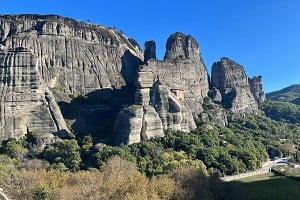
Looking to make the step up to multi-pitch routes? British Mountain Guide Polly Harmer recommends her top beginner spots in North Wales.
If you've been trad climbing on your local crags and you're starting to plan a bigger multi-pitch trip, then North Wales is a great place to start. This relatively compact area offers loads of multi pitch crags with some very good climbs in the lower grades, plus some locations which offer less committing adventures. There's also a wealth of rock types, which adds variety to the character of the climbs here.
North Wales has lots of micro-climates, meaning that if the weather is poor in the mountains, there's a chance you'll find dry places to climb on or near the coast. The other advantage of the multi-pitch crags here is that there are various spots which have a lot of atmosphere yet are only a short walk from the car, which means less time walking and more time climbing.
Skills required:
There are a few skills which are handy to have before you take yourself into a multi-pitch situation. You should already be comfortable and feel confident in your skills on single pitch climbs, at whatever grade you climb. So, what else is handy to know if you plan to do two pitches or more in sequence?
The longest-pitched climb in the UK is called Long Climb on Ben Nevis, and it comes in at 420m and normally gets climbed in eleven long pitches. In theory, it's the same set of technical skills that you'll need to do a two-pitch climb as it is to do an eleven-pitch climb, however there's a great deal more commitment, route finding, and efficiency needed when the number of pitches starts to add up.
When you start treading on multi-pitch terrain, it's a good idea to build up the number of pitches you add into your single-pitch game. I'd suggest you drop a grade or two and enjoy the experience without also pushing your climbing grade at the same time, then you'll have more in hand to deal with sticky situations if they arise.
Pitch lengths on mountain crags can be up to 50m, compared to the 15m pitches you find at Stanage, so you might need a little more endurance and a bigger rack of gear. Team line-up and communications are worth a second thought to avoid getting yourselves into a pickle high up on some foreign ledge.
There is a certain seriousness, which only the prepared will avoid meeting with, that comes with the terrain of multi-pitch crags; getting lost on the descent, marooned and crag-fast in the dark, or being unable to descend in the rain. If you're not sure about any of these risks, it would be quite wise to clear things up through practice - perhaps with an instructor or guide - before heading out on a multi-pitch route.
I've chosen six multi-pitch crags in North Wales that I feel are good places to kick off:
1) Lion Rocks: the multi-pitch training crag
Lion Rocks sit just above Padarn, the lake of Llanberis. Our first suggestion isn't actually a 'real' multi-pitch crag, but is a great place to practise skills due to its large belay ledges and many options for building stances and 'escaping' by walking off should you wish.
It's used for kids' group sessions and most of the climbing is on the edge between graded rock climbing and scrambling, but it's a beautiful spot with value as a multi-pitch training venue.
2) Tryfan Fach: the mini-mountain
So-named as the smaller shadow of its bigger neighbour, which rises up to its west. As one of the crags with a heap of lower grades, it can become very busy with families and learners. This is worth bearing in mind if you like some peace and quiet. In line with this, parking can be tricky in the busy months. The crag faces west, is quick drying and offers an excellent slab for introducing multi-pitching. Plus, it's only ten minutes' walk from the car.
I like Little Tryfan Arete (D) as it's a nice route with good stances and there's something special about the position it offers. Although there aren't many starred routes here, they are all well-travelled, meaning gear placements are obvious and the rock is solid. Unlike many of the other crags noted here, the walk off from the top is simple and quite hard to get wrong.
3) Clogwyn yr Oen (Moelwyns): The outlier
There are a few good entry level routes here which make it worth the drive further south (one hour from Llanberis), the crags face south and can get better weather. The approach is very straightforward, following a tarmac road until below the crag. Up the road you'll find Clogwyn yr Oen, which has a lot of good 3-4 pitch routes for the beginner multi-pitcher, at VDiff to Severe.
The rock is quite interesting, with rough grained volcanic features that can be really enjoyable to climb but can sometimes mean the gear feels slightly pokey. The stances are mostly big enough to feel comfy on and allow space for you to manage your faff. It's important to have a good system for carrying your trainers up the routes, as the descent is a bit tricky to navigate and involves some loose scree. The star of the crag is Kirkus's Climb (VD), with obvious stances and a natural line culminating in a fantastic third pitch.
4) Holyhead Mountain: Coastal multi-pitch
Holyhead offers mini multi-pitch routes in often better weather than that on the mainland. It's about an hour's drive from Llanberis, but it provides a lovely change of scene. The gear placements can be a little tricky and the quality of the easier/mid grade routes are not so high, but the situation is fantastic.
However, Holyhead Mountain has the same rock type (Quartzite) as the Gogarth sea cliffs and therefore acts as a great training ground before heading down to the more committing joys of the awesome sea cliffs which lie below.
5) Craig Bwlch y Moch (Tremadog): The Sporting crag
Bwlch y Moch is a great cliff with high quality rock and is road-side, so the approaches should take no more than five minutes. However, don't assume a simple start to the day as if you don't know your way about, it can be hard to locate your chosen route. Tremadog is owned by climbers, as the BMC bought it in 1979 to protect access for us to climb on it. Tremadog is low-lying (set at sea level) so it's possible to climb here even in the winter while it's in the sun.
The classics at Tremadog are fantastic places to start, including Christmas Curry (S 4a), and Hail Bebe (VD). Bwlch y Moch is a good place to kick off if you're cruising at VS-HVS as there are some great 2-3 pitch routes that are slightly less committing than the mountain crags or sea cliffs in the area. Examples include Striptease (VS 5a), and the awesome route of two halves, Slack HVS variation (HVS 5b). The descents tend to involve muddy steep 'footpaths' which require care. There are a few in situ (fixed) abseil spots which can be handy, but are fraught with potential risks and have been the sites of many stuck ropes, angry meetings with oncoming traffic, and worst of all: too-short ropes.
6) Llanberis Pass: The epicentre
'The Pass', some might say, is the epicentre of British rock climbing. Every bit of rock you see has been climbed — and there are a lot of rocks in that valley. There's a lot of awesome climbing, which really kicks off from about VS and the grades in The Pass are traditionally quite stiff, so it's best to try some of the easier offerings available first.
Dinas Cromlech has a great route called Flying Buttress (VD), Dives/Better Things (HS 4b) is another classic and there are of course some really worthwhile VS climbs.
Carreg Wastad is another good south-facing crag with more mid-grade routes including Ribstone Crack (VS 4c) and Skylon (HS 4b), although be wary of any looser rocks. For both of these crags in The Pass, it's important not to take the descents too lightly as they are both pretty involved and call for some scrambling skill and decent footwear.
7) Idwal Slabs (aka Cwm Idwal): classic mountain multi-pitch
I wondered if it would be possible to leave out the Idwal Slabs from this list, but ultimately I decided it's not. The Idwal slabs are a site of many a good epic, but also many good memories of first multi-pitch adventures. The routes on the slabs are not to be underestimated; despite the lower grades, they are long, committing and should you make it to the top, it's no easy place to get off.
Cwm Idwal is a beautifully wild spot with a lake and lots of atmosphere. It can become busy on weekends, so get there early to avoid being stuck in a queue, or worse — causing a queue. All of the routes here are awesome and if you're going well, options for extending the day are plentiful; you could climb from Hope (VD) into Original Route (VS 5a) on Hollytree wall, and then on to Continuation Crack (HVS 5a) on Continuation Wall, before wandering over to climb Cneifion Arete (D) - a fantastic Welsh link-up of 250m and fourteen-ish pitches for the budding alpinist.
This is just a quick introduction to some of the multi-pitching available in one of the UK's premier rock destinations. For more information, read a guidebook or hire an instructor or climbing guide, of which there are many in North Wales.
Guidebook
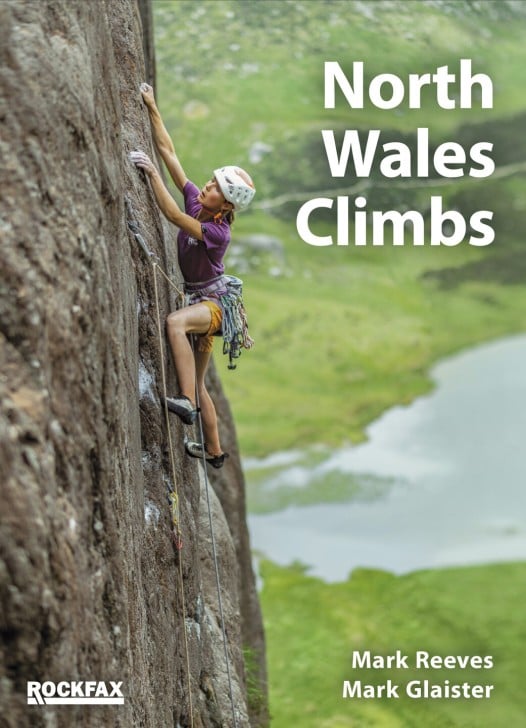
North Wales Climbs
North Wales Climbs spans the major mountain crags from Llanberis Pass, to Cloggy; and from Ogwen to the Carneddau. It also includes the Llanberis Slate quarries, Tremadog, the Moelwyns, the Gwynant Valley, Mid-Wales, Gogarth and the Ormes of Llandudno. As is normally the case with the selected Rockfax guidebooks, the choice of what to include is based as much on the crag it is on as the route itself. If we include a crag then we tend to include a good selection of routes on that crag.
The 2023 edition builds on the successful 2013 edition with many extra routes and mostly new aerial crag photography throughout. All the maps...
More info


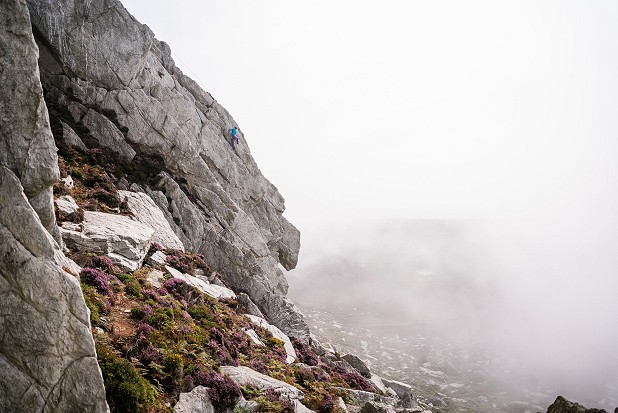
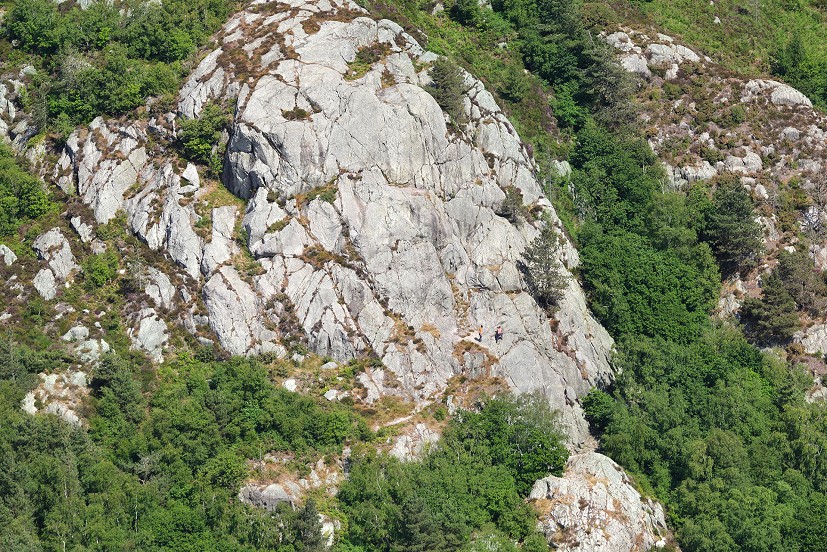
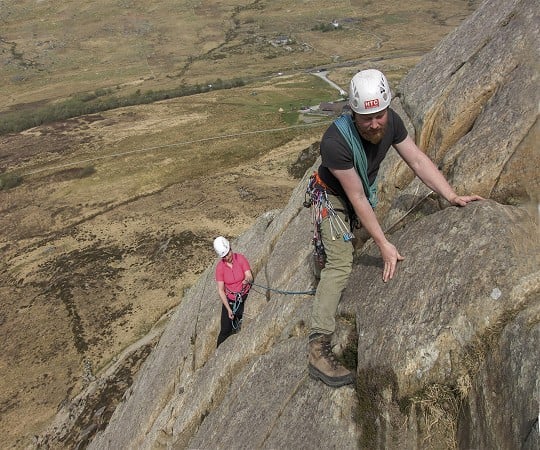
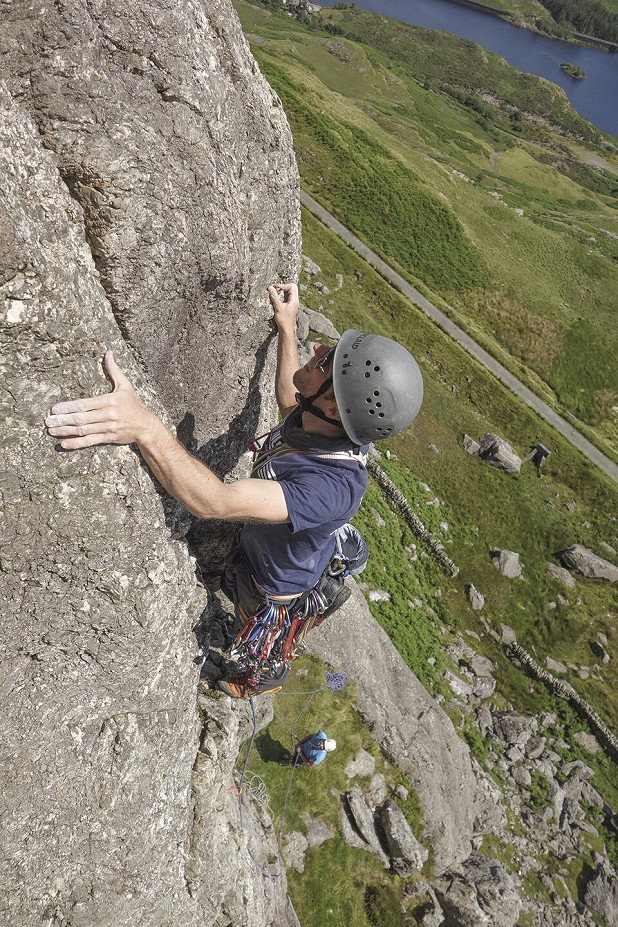
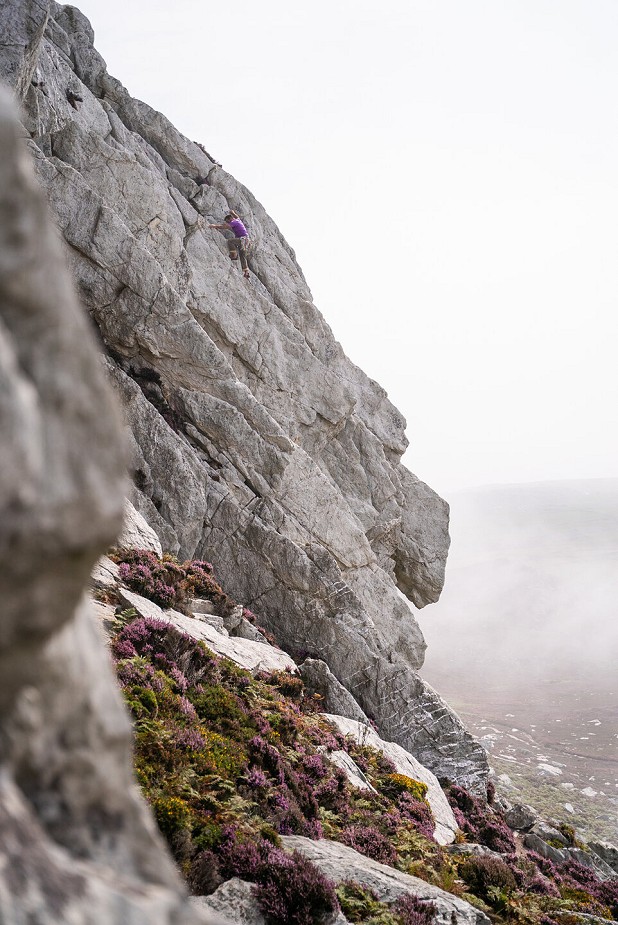
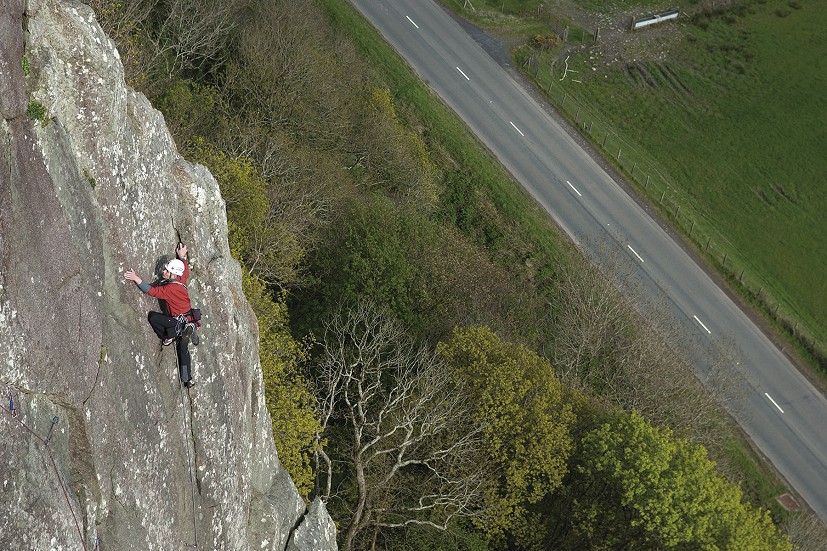
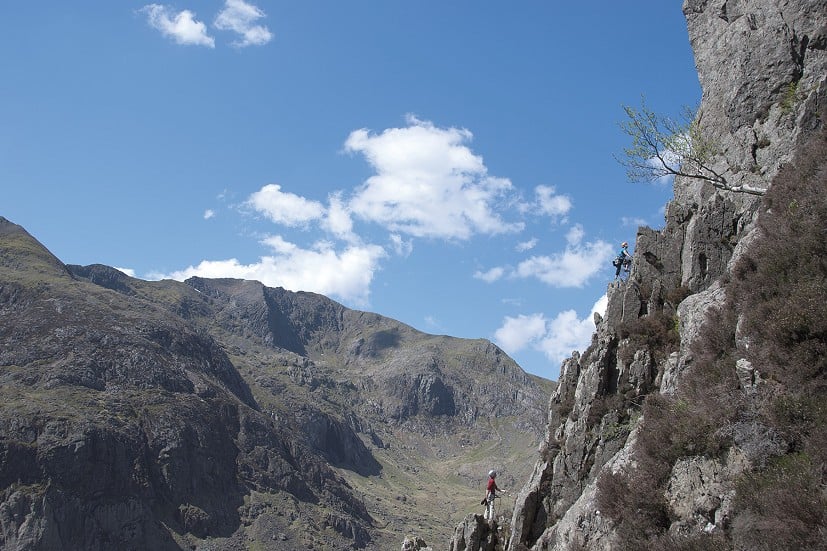
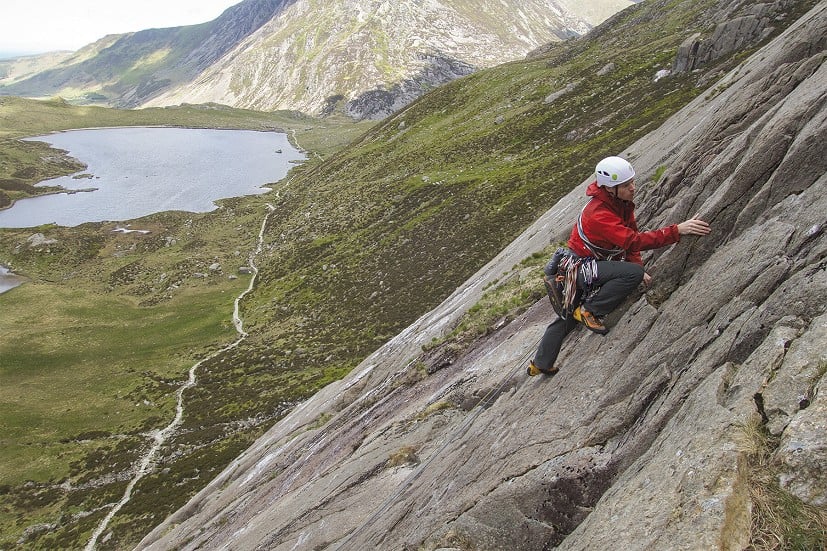

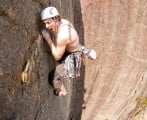






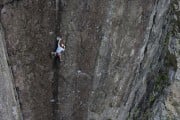


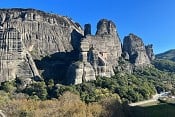
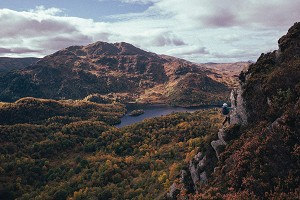
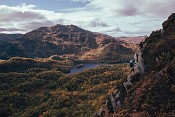
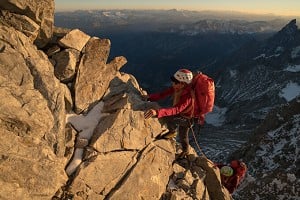
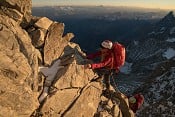





Comments
A welcome article with a selection I agree with. As a minor point it would have been nice to see a warning about the standard descent for the longest lower routes on Idwall Slabs, as this can become a cold snarl-up leading to too many MR call- outs. If there is any queue at all it's quicker and way warmer to scramble up left of the upper walls and take the path down from Cwm Cneifion. Milestone Buttress too often suffers a similar problem, where again you can scramble up and walk off behind.
Whilst I don't doubt the good intentions behind that article, some of the suggestions are a bit rum. I wouldn't hesitate to climb Striptease or Continuation Crack with someone new to multipitch climbing, as I wouldn't even attempt them with someone new to that part of the game.
Otherwise, there are some good suggestions for venues there. The most important things I've always found when climbing with someone that hasn't done a multipitch route before are a refresher on calls are going to be used and having a clear line of sight so that progress can be assessed and help offered if needed. It's the second reason that makes the Slabs so popular as a venue for starting longer routes.
T.
That all depends on the skills of the 'beginner' who is maybe progressing well climbing outdoors but is new to multipich. I've taken such who were good on gritstone cracks to second me up those. The biggest issue I've seen for those on their first multipitch (in taking hundreds there over the decades, in a Uni club, and talking to Ogwen MR quite a few times) seems to be escape (due to unexpected bad weather, queues or a minor accident) or tricky descents, slowing things and leading to exposure.
A nice article. However my strong advice to people reading it and contemplating these routes is this: get a guide, at least for a day or two.
These days people think that if they've got the right gear and they can 'build a belay', it'll work. There's a ton of things which can go wrong - communication, routefinding and weather, to name but three. A guide won't just check out your technical skills (e.g. placing gear). Hopefully some 'climbing wisdom' will be imparted. And ultimately it's 'climbing wisdom' which will keep you alive.
Anyway, good luck to all heading out on these routes. A lifetime of adventure beckons. Just be as safe as you can.
Mick
My experience as a relative beginner who's led a handful of these routes, minus a guide or mentor.
After spending a season on the grit I was eager to try some multipitch. Having no formal training or mentor, and armed only with my at the time meagre rack and totally inexperienced girlfriend I decided on Flying Butress on the Cromlech to start. What an adventure it was, the climbing was easy for me, but the nerves and feeling of questing into the unknown was strong. I worried about the top pitch, wondering if my girlfriend would struggle. But we got through it. Enough excitement for one day.
The following day we went back to the Pass, and set off on Crackstone Rib. Perhaps a bit ambitious in hindsight, but all's well that ends well. I laced the traverse and rib with gear. Alas, when I arrived on the ledge I had nothing left but a few slings. Took a bit of imagination to build a belay. My poor girlfriend dare not look down on the rib. 'Just keep climbing and I'll keep taking in I said'.
The second pitch contains the only move of any difficulty, subjectively of course. She just couldn't do it. However, fortunately you can avoid it entirely by dropping to the ledge and traversing below it. Another great adventure and more than enough for a weekend.
I've since been back and done a fair bit of the list in the article. And other great easy adventures in the lakes and Cornwall. I always keep them well within my physical ability. And back off when we can't continue or it feels unsafe. I've backed of Noahs Warning at the Cromlech, and gone back the following year to cruise up it.
Overall a good article, some of the routes seem stiff, but the willingness to back off and go home should be highlighted for sure